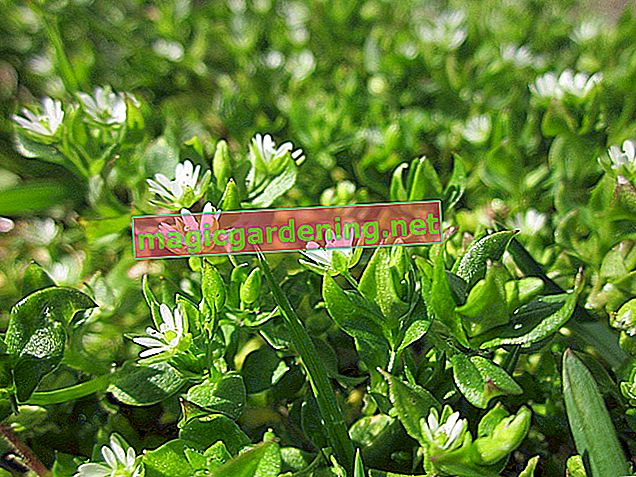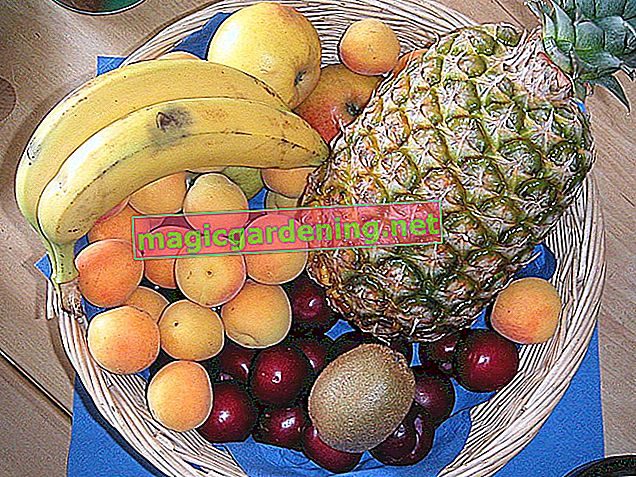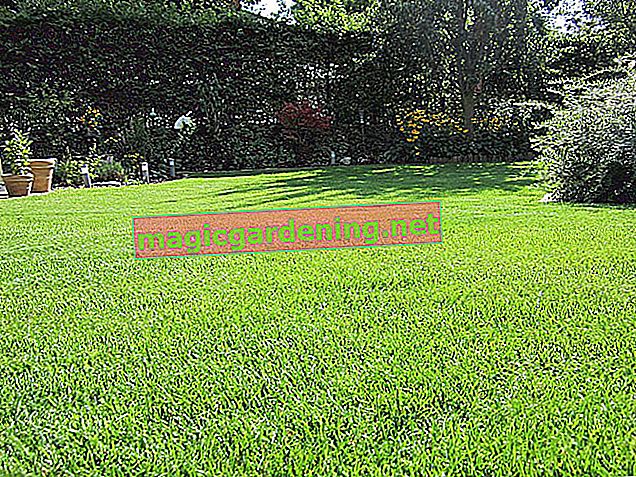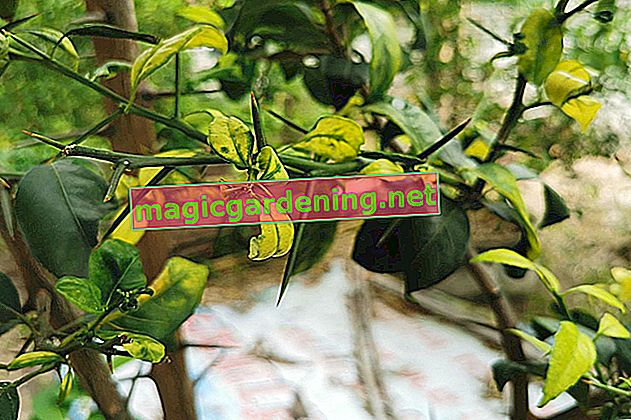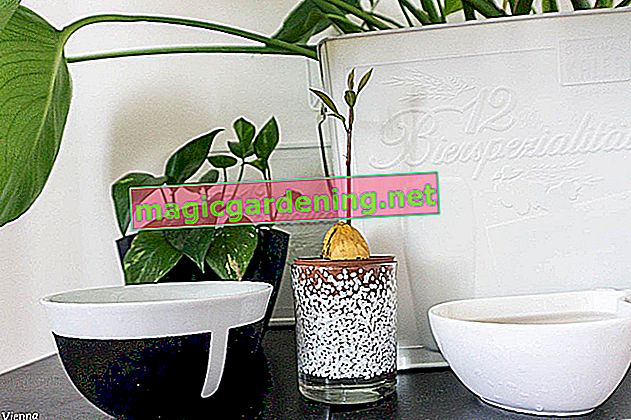
the essentials in brief
- A soil analysis provides information about the nutrient composition or pollutants in the soil
- Simple soil analyzes are available for € 20, complex analyzes cost between € 50 and € 90
- A soil sample should be taken from a depth of 15 to 90 cm, depending on the soil to be analyzed
Why a soil analysis is important
In agriculture and arable farming, detailed studies are important for optimal yields. A soil analysis provides information about the nutrient concentration in the earth. Nutrients are essential for healthy growth. However, the availability of nutrients is influenced by several factors. To get reliable results, you should send a soil sample to a laboratory.
also read
- Find out what's wrong with the lawn through soil analysis
- Which is better: rolling lawn or sowing it yourself?
- Propagate laurel for planting hedges or as a kitchen spice yourself
Soil analyzes provide information on:
- Nutritional content
- PH value
- Soil type
The soil is a sensitive structure whose properties influence plant growth.
What is examined in a soil analysis

For hobby gardeners there are various soil analysis packages that are geared towards specific parameters. In the standard examination, the soil is examined for the concentration of nutrients and trace elements that are important for plant growth.
If you want to find out more about the nitrogen content in the soil, you need to book special analysis packages. This investigation is associated with increased effort, since nitrogen is usually present as nitrate and is mobile. In the course of the year the concentration fluctuates strongly, because nitrate is washed out by heavy rain.
You can also have the substrate from your garden checked for pollutants. Heavy metals are a natural component in the soil and are dissolved through weathering. The toxic substances can also accumulate in the garden soil through exhaust gases, contaminated sites or topsoil from unknown sources.
| examination | Result | |
|---|---|---|
| Soil nutrient analysis | Quality of the soil | Fertilization recommendation |
| Soil test for pollutants | Heavy metal pollution | understandable analysis report |
| Yield soil analysis | available mineralized nitrogen | Fertilizer indication |
| Soil analysis nutrient by crop | Nutrient analysis with a focus on the cultivated plant | Fertilizing tips |
Soil analysis costs
Hobby gardeners can also make use of soil analyzes. The prices vary depending on the selected test. A simple soil analysis costs around 20 euros. It contains analyzes of soil type, pH value, humus content and the concentration of important nutrients and trace elements. More elaborate analyzes that check the concentration of nitrogen, other trace elements or heavy metals cost between 50 and 90 euros.
Soil analyzes are offered here:
- Raiffeisen laboratory service
- Agricultural investigation and research institutes (short: LUFA)
- Pharmacy laboratory
- Soil analysis center Reblu GmbH
Buy sets
Dehner offers a soil analysis set for around 20 euros, which includes a shipping bag and instructions for taking soil samples. The sample is then sent to a laboratory for analysis. To see the results, you need to download a special program. In addition to the analysis results, you will also find fertilizer recommendations here. Sets with a broader analysis spectrum are also available at the soil analysis center or in the pharmacy laboratory.
Carry out soil analysis yourself

The possibilities for independent soil analysis are limited, as the majority of all parameters cannot be researched without special means and equipment. The cost of such equipment is in the range of several hundred euros and is therefore not worthwhile for private use. You can, however, determine the soil composition and pH value yourself.
Tips
In spring, many garden centers offer free soil analyzes.
Take soil sample
The type of use is important, because this differentiates between the depth at which you should take the soil sample. In order for the soil to provide the most meaningful results possible, you should take around ten samples at different locations in each usable area. Use a dandelion cutter that is pierced vertically into the ground and slowly pulled out.
How deep to pierce:
- Lawn : ten to 15 centimeters deep
- Vegetable garden : 20 to 25 centimeters deep
- Perennials : 20 to 25 centimeters deep
- Permanent crops : 90 centimeters deep
- Trees : 90 centimeters deep
You get a cross section through different layers of the earth. The samples from a usable area can then be mixed or analyzed individually. In order to go deeper, you should get a drill stick. This can be purchased or rented in garden centers.
Check the composition of the soil
Basically, the soil types clay, silt and sand differ depending on the grain size proportions. Clay contains all three grain fractions, which can be present in different proportions. The soil properties depend on the dominant grain fraction.
| Malleability | consistency | nature | |
|---|---|---|---|
| Clay | variable | variable | variable |
| volume | easily malleable | sticky | leaves dirty traces, shines |
| Silt | moderately malleable | little sticky | velvety-floury to rough |
| sand | not malleable | grainy | crumbled, crumbly |
Finger test
You can test the rough soil composition yourself with a simple finger test. Slightly moisten the soil from the sample and take a tablespoon of the substrate in your hand. Then try to shape the substrate into a pencil-thick roll. This works out differently depending on the nature of the soil.
Either the substrate crumbles or it can be shaped. In this case, you can continue kneading and shaping the sausage. Notice whether the substrate becomes cracked or solid. Crackling noises indicate a share of sand.
How to test the soil composition:
- Substrate not malleable, does not adhere to the lines of the hand: sand
- Substrate not malleable, not cohesive, floury: silt
- Substrate not malleable, gray-black color, with organic residues: humus
- Moldable substrate, matt surface: clay
- Substrate very malleable, not cracked when rolling out, shiny: clay
Determine the pH value
The Neudorff pH soil test, which you can buy at Obi, for example, provides information about the pH value by means of color reactions. To do this, some soil is put into the test glass contained and filled with distilled water. After a test tablet has been added, close the jar with a cork and shake it vigorously until the tablet is completely dissolved.
The sample is left to stand for about half an hour so that the soil can settle. You can then compare the color of the water with the enclosed color palette and read off the pH value.
Floor testers hardly provide any useful results

There are devices for independent checking of the pH value, incidence of light and humidity. The market offers inexpensive models that cost between five and 20 euros and work with or without a battery. Most of the time, such devices are unusable because they only provide rough guide values or cannot correctly determine the pH value.
Tips
If you are interested in a floor test device, you shouldn't go for the cheapest models.
Soil analysis with a fertometer
Such devices are equipped with a brass probe, which measures the conductivity of the soil and thus the amount of ions in the substrate. When nutrient salts dissolve in moist soil, they are available to the plants. These so-called EC measuring devices (English: electrical conductivity for electrical conductivity) measure the concentration of soluble salts and show whether the nutrient supply is in order or whether the substrate should be fertilized. The probe is inserted into the substrate. A button is pressed to start the measurement. The device then gives fertilizer recommendations by means of three light-emitting diodes.
Disadvantage:
- no detailed information on nutrient composition
- no statement about nutrient replenishment due to the breakdown of organic substances
- no information about the ratio of nutrient salts to each other
Digression
Electric conductivity
In order for a substance to be conductive, it must have many freely moving charge carriers. Metals have charge carriers in the form of loosely bound electrons, but ions also serve as conductive molecules. Ultrapure water has a certain conductivity, which is increased by adding salts. These release ions in aqueous solutions.The electrical conductivity is given in Siemens per meter. When a plant is growing, an electrical conductivity below 0.35 mS / cm is too low. The fertometer lights up yellow and indicates that more fertilization should be used. A value of more than 1.0 mS / cm is harmful to the plant in the long term, as too many salts are dissolved and therefore available to the plant. The device lights up red.
frequently asked Questions
Who has to do a soil analysis?
There is a fertilizer ordinance that is mandatory for farms. According to this, farmers have to have their soil nitrogen determined by a laboratory analysis once a year. You can also use results from comparable areas and determine the fertilizer requirement accordingly. The values are published in weekly agricultural newspapers. An analysis of phosphate on usable areas from a size of one hectare, which is carried out at least every six years, is mandatory.
Why is phosphate determination so important?
Phosphorus is an essential substance for plants, which is present in the soil in the form of various phosphates such as potassium, calcium or magnesium phosphate. The availability of phosphorus is highest at a pH value between 6.0 and 7.0. Excess phosphates can, however, be washed out, thereby ending up in groundwater, surface water and other ecosystems. With the help of a phosphate determination, fertilization appropriate to the area can be determined.
What are DWD soil analyzes?
The German Weather Service (DWD for short) carries out soil analyzes in order to produce soil weather maps. These provide information on numerous meteorological factors such as visibility, wind, clouds, air pressure and air temperature. So this soil analysis has nothing to do with the analysis of the substrate in your own garden.
What is LAGA soil analysis?
The Länder Working Group on Waste (LAGA for short) deals with the enforcement of waste law in Germany. The LAGA is mainly important for construction and renovation measures. This results in excavation which must be thoroughly examined by means of soil analyzes. This is checked for various hydrocarbons, pH value and heavy metals, among other things. Such analyzes are not necessary for private house construction, but can also be used by private individuals. The examination of a soil sample costs 600 euros.

